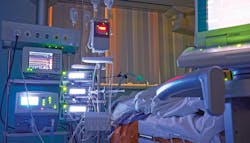Most U.S. healthcare organizations have disaster preparedness plans in place to address infectious disease outbreaks, man-made or natural disasters, bioterrorism or other events that result in a surge in demand for patient care. But COVID-19 aka “Coronavirus” has unleashed an epidemic that has left the U.S. healthcare industry reeling. Surging cases and supply shortages are necessitating close collaboration among critical care clinicians and supply chain teams to direct supplies, capital equipment and services to where they are most needed.
In this article, HPN presents perspectives from clinicians, supply chain professionals, manufacturers and technology providers on the importance of critical care/supply chain collaboration to combat COVID-19.
Recognize and address potential shortages now
Mike Schiller, Senior Director of Supply Chain, Association for Health Care Resource & Materials Management (AHRMM), acknowledges how hospitals are currently facing respiratory equipment shortages, including N95 respirators, ventilators and accessories. He says personal protective equipment (PPE) including gowns, gloves and respirator masks, ventilation and other drugs, and blood supplies are the most affected supply categories.
“AHRMM is actively working with healthcare leaders, associations, suppliers and distributors from across the healthcare field, sharing information and solutions around resource allocation conservation, supply continuity and availability,” said Schiller. “Healthcare organizations are encouraged to work with their suppliers, understand product shortages and allocations they may be facing or expect to face, and identify and implement conservation measures, as well as work with their state and local emergency management agencies.”
Schiller recommends that healthcare organizations visit the Centers for Disease Control and Prevention (CDC) and Food and Drug Administration (FDA) COVID-19 websites, which offer a variety of resources and information. This includes CDC’s Healthcare Supply of Personal Protective Equipment, and Strategies to Optimize the Supply of PPE and Equipment, and the FDA’s Emergency Use Authorizations website pages. AHRMM also has a comprehensive COVID-19 resource page, which includes links to numerous agency resources and information, vetted and approved non-traditional suppliers, and collaborator associations and organizations.
Suppliers ramping up
Healthcare suppliers, particularly those that produce respiratory and PPE products, are increasing their manufacturing capabilities to meet growing demand worldwide. For example, Dräger has already significantly expanded its production capacities and is working to expand them even further as demand continues to grow.
“Our technology for life is needed now more than ever,” said President and CEO for Dräger in North America, Lothar Thielen. “We are seeing a significant increase in global demand for our ventilators, the corresponding accessories and personal protective equipment. We are doing everything in our power to fulfill our social responsibility to provide for society - worldwide. The fact that we invested in a future-oriented factory with state-of-the-art industrial production methods several years ago is bolstering the success of our efforts.”
Stefan Dräger, Chairman of the Executive Board of Drägerwerk Verwaltungs AG, stated in the press release: “I am aware that despite all our efforts we can only partially meet the current demand in the world. And believe me, we would like to do even more. But I can assure you: We do what we can. Our thoughts are with the doctors, nurses and rescue workers who are currently doing a great job for patients and society at large.”
Changes in clinical mindset
John Cherf, MD, MPH, MBA, Chief Medical Officer, Lumere and CIOO of Chicago Institute of Orthopedics, says COVID-19 is requiring clinicians to have a change in mindset better aligned with how supply chain allocates limited resources.
“This requires an entirely different approach - it’s about prioritizing societal needs,” Dr. Cherf added. “In order to be successful, caregivers must be equipped with the right information and tools. We must improve how clinicians and supply chain teams are collaborating in real-time. I believe in the end this public health crisis will accelerate positive system-wide change.”
Build trust and foster collaboration
“We are seeing a shift where more supply chain leaders have a medical background (e.g. RN),” said Dr. Lyles. “This has enabled them to build credibility and bridge effective strategies between clinicians and supply chain groups. Another best practice would be to have alignment from leadership (the c-suite). While it’s hard to predict an outbreak or the type of infectious pathogens (e.g. bacteria or virus), engaging everyone can help identify ways of cost saving and preparing for some level of disruption during an outbreak.”
Medline recently talked to experts to reveal how good infection prevention protocols, products and emergency preparedness help hospitals tackle today’s new norm. The video can be found here: https://youtu.be/zbQ6hUzVymQ.
Bob Boswell, President and Chief Executive Officer, LeeSar/CSF, urges clinicians to trust that their supply chain teams will provide them with the supplies that they need. He acknowledges that there is a supply shortage but asks clinicians not to hoard supplies because that could result in another department or facility not having what it needs for patient care.
“Clinicians need to understand that no one is holding supplies back, there is a true shortage in the country on these supplies,” said Boswell. “Hospital executives know the hot spots where supplies are urgently needed and their supply chain is working to get products to those locations. We have calls with our members every day to see how we can reallocate where necessary.”
Conway adds that supply chain professionals can leverage their experience to predict and plan ahead for upcoming spikes in demand for other products, such as filtration supplies that will be needed to support extended ventilator use. As the disease progresses, close coordination with clinical leaders tracking the surge in patient demand can also help supply chain predict the types and quantity of products that will be required and where.
“Be cautious, but calm,” said Stowe. “Ensure judicious use of supplies. Don’t hoard wipes, masks, etc. Make sure you have frequent communication amongst the hospital leadership to maintain adequate supply levels. Make sure you know the protocols for emergency preparedness and surge capacity and/or where to find them.”
“Also, listen to your infection prevention team, especially when it comes to the appropriate personal protective equipment to wear and when,” said Alice Brewer, Director of Clinical Affairs for Tru-D SmartUVC. “Surface and equipment disinfection is also key so ensure that you’re cleaning the surfaces when visibly soiled, in between patients and at regular intervals if needed. This was especially key in the Ebola situation, when cleaning and good hand hygiene really made a difference.”
Brewer notes how on March 10, 2020, the CDC updated its recommendations to refer to List N on the EPA website for EPA-registered disinfectants that have qualified under EPA’s emerging viral pathogens program for use against SARS-CoV-2. Many PDI products can be found on List N, including Super Sani-Cloth Wipes, Sani-Cloth AF3 Wipes, Sani-Cloth Bleach Wipes, Sani-Cloth Prime Wipes, Sani-Prime Spray, Sani-HyPerCide Spray and Sani-24 Spray.
“Tru-D does not claim that its technology will treat COVID-19 or eliminate COVID-19 because there’s not enough data at this point. However, in the past, Tru-D has been shown to be very effective against other coronavirus strains,” Brewer added.
Enhance communication
With the rapid spread of COVID-19 and pressure on health systems and hospitals to stock supplies and properly allocate them to where they are most needed, healthcare supply chain teams and clinicians must find ways to better communicate.
“When effective communication methodologies are established, everyone benefits from improved operational efficiency and increased patient capacity management,” said Zebra TechnologiesChief Nursing Informatics Officer (CNIO) Rikki Jennings. “Asset tracking solutions also help keep track of critical items within the clinical care environment including tracking, cleaning, calibration and other maintenance tasks. Using these solutions to develop best practice strategies is crucial during times of crisis.”
“One best practice is the utilization of purpose-built mobile devices featuring healthcare-grade plastic material designed to reduce the spread of infections, sturdy exterior shells, long battery life and industrial-strength scanning for data capture accuracy for bringing real-time data to the point of care,” Jennings added. “These devices need enterprise-class security and manageability options to facilitate quicker, more seamless communication between caregiver team members, the caregiver community and patients themselves. These staff communications tools can help clinicians, pharmacists and supply chains coordinate and prioritize activities.”
Resiliency mapping
The availability of supplies is impacted by not only what is happening within a healthcare facility but also the environment in which the supplies – and/or their components - are manufactured. For example, when Hurricane Maria devastated Puerto Rico’s pharmaceutical manufacturing industry this resulted in a national shortage of IV solution bags in the U.S. for months following the natural disaster.
To address these issues, Dartmouth-Hitchcock Health has employed a resiliency mapping technology (Resilinc) that enables the health system to map out where its suppliers manufacture products across the world, right down to the exact manufacturing sites. Through the mapping solution, they have identified that Dartmouth-Hitchcock Health relies on 628 suppliers (323 Tier I and 282 Tier II and 23 Tier I & Tier II), covering 3,663 unique sites in 73 countries. They are in the process of fully mapping their item master to where supplies are manufactured.
“With COVID-19 these alerts give us a slight head start on addressing potential supply issues - a pre-warning of what could be a disruption,” said Lancaster. “For example, if we know that a certain region where our suppliers manufacture their products is going on lockdown and people cannot leave their houses to work in the manufacturing plants we can take steps to identify new supply sources.”
Going forward, Conway hopes hospitals consider how manufacturers are mitigating upstream supply chain risk when sourcing and contracting for products. “This current crisis highlights the risk of over-prioritizing acquisition price, which has contributed in part to manufacturers moving production capacity offshore and/or relying on single and often the same upstream suppliers as their competitors,” she said.
Inventory tracking
Supply chain’s ability to track inventory is important for patient care and safety in any situation, but it is critical during an infectious disease outbreak when healthcare organizations must supply life-saving products where they are most needed.
“The technology and software used to support supply chain operations needs to be able to respond quickly to a disaster situation,” said Nancy L. Pakieser, Sr. Director, Industry Development, Tecsys. “The time for preparation is prior to an emerging event. Most healthcare systems have disaster preparedness plans in place that they are now deploying.”
“At a minimum, supply chain technology needs to support lot and serial number tracking, which is of heightened concern in an infectious disease outbreak,” Pakieser added. “It needs to provide end-to-end visibility and track the movement of supplies, vaccines and medications so the deployment – or reallocation – is seamless and efficient. It really is about how you can leverage your supply chain processes and technology tools to accommodate a changing situation while delivering the utmost care to the areas in greatest need.”
Equipment maintenance, repairs and availability
Lancaster calls attention to a secondary issue related to medical equipment availability, having the parts and personnel to keep existing assets up and running. For example, in the treatment of viruses that can cause respiratory issues, such as COVID-19, ventilators are a critical, but limited asset. Therefore, hospitals must properly maintain capital equipment such as this to avoid patient care disruptions.
“Dartmouth-Hitchcock Health is preparing for another wave of challenges related to the global COVID-19 outbreak; the availability of clinical engineering supplies and repair parts for critical medical equipment,” said Lancaster. “Let’s say a factory that manufactures chips and other parts for large imaging equipment shuts down. Fast forward three months and all of the parts in the pipeline have been consumed, no new parts are being manufactured and hospitals have no way to repair the imaging equipment.”
“Therefore, we are preparing for a bulk buy of products that we know are routinely used in maintenance and repair to avoid potential shortages and keep our equipment up and running for clinicians and patients,” Lancaster added.
Wolfgang Hares, Director Scientific Affairs and Global Breathing, Pall Medical, explains how a respiratory virus, such as COVID-19, has the potential to contaminate respirator machines, rendering them useless.
“Once a virus, bacterium or fungus enters a ventilator it then can potentially infect every patient on which it is used from then on,” said Hares. “Once it is deemed a ventilator is contaminated, the time needed to sanitize the machine is time away from treating patients. In extreme cases that may even be a $40k/$50k loss if that machine can never be cleaned. Therefore, hospitals must use the proper filtration to protect not only patient but also long-term supply of machinery for this outbreak.”
“Clinicians in the U.S. might be faced with situations where they have very limited access to ventilators, yet have many patients who desperately need a ventilator in order to survive,” Hares added. “How do you choose which patient to treat? If a hospital doesn’t have enough machines available, then clinicians might be forced to consider using a contaminated machine just to keep a patient alive. Nobody wants to be in that situation so healthcare providers must act now to protect their equipment.”
Impact on future supply chain
Dr. Cherf believes COVID-19 will have a significant, permanent impact on healthcare supply chain in the years ahead.
“When you think of other infectious outbreaks, such as SARS, Ebola and MERS, they were somewhat localized,” said Dr. Cherf. “COVID-19 is infecting people on a much broader scale, placing intense pressure internationally on the supply chain. I would venture to say that when all of the dust settles and this infection subsides it will be an indisputable fact that supply chain is an integral part of the health of global healthcare.
“This is probably the most pressure on our healthcare system in living history and I think we can manage it - provided we rally around information and best practice sharing,” Dr. Cherf added. “One thing we are finding with this crisis is that it is inspiring ingenuity, creativity and entrepreneurship in our country. For example, hospitals are using new algorithms and workflows for improved utilization of supplies to determine who truly needs to be tested and treated. I believe healthcare will be much smarter in how it stratifies patient populations in the future. We will be much more creative in the way we deliver care, plan for supply shortages, and source critical supplies in the future than we have been in the past.”

















